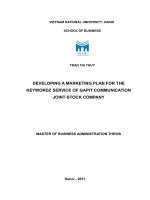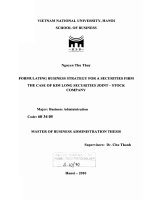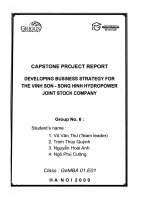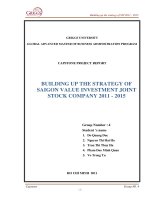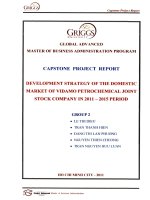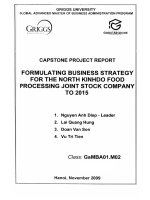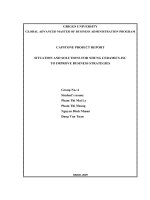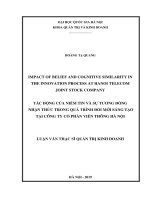(Tiểu luận) the superdong fast ferry kien giang joint stock company
Bạn đang xem bản rút gọn của tài liệu. Xem và tải ngay bản đầy đủ của tài liệu tại đây (1.65 MB, 29 trang )
<span class="text_page_counter">Trang 1</span><div class="page_container" data-page="1">
<b><small>HO CHI MINH CITY OPEN UNIVERSITYSPECIAL TRAINING DEPARTMENT</small></b>
<small> </small><b><small> </small></b><small> </small>
<b>REPORT FINANCIAL ANALYSIS</b>
<i>JOINT STOCK COMPANY</i>
<b>Lecture: Ph.D. Do Thi Thanh Nhan </b>
<small>Group member: 1. Pham Huong Giang – 20540420582. Nguyen Thanh Hang – 2054042073</small>
<small>3. Nguyen Tuong Nhi – 20540421974. Hoang Khai Huyen - 2054042098</small>
<small>Class</small><b><small> : KT20DB02</small></b>
<b><small>Ho Chi Minh City, 17th December 2022</small></b>
</div><span class="text_page_counter">Trang 2</span><div class="page_container" data-page="2"><i>ABOUT THE SUPERDONG FAST FERRY KIENGIANG JOINT STOCK COMPANY</i>
<b>name</b> <sup>Cong ty co phan Tau cao toc Superdong-Kien Giang</sup>
<b>English name</b> Superdong Fast Ferry Kien Giang Joint Stock Company
<b>Headquarters</b> <sup> 187 Nguyen Trung Truc Street, Quarter 5, Duong Dong Ward,</sup>
Phu Quoc City, Kien Giang Province.
</div><span class="text_page_counter">Trang 3</span><div class="page_container" data-page="3">The company was established and put into operation on 11/14/2007 with the name Superdong - Kien Giang High Speed Train Company Limited and the initial registered charter capital was VND 9.6 billion. The main activities of the company are Coastal passenger and cargo transportation, passenger and cargo transportation by inland waterways. On January 22, 2010, the company changed its form into a joint stock company. On July 8, 2014, all 17,474,854 shares of SKG were officially traded on HO
The company started its business on the Rach Gia - Phu Quoc route with only one Superdong I high-speed train with a capacity of 171 seats. By 2010, the Superdong brand had been trusted and chosen by customers and rose strongly, reflected in the strong growth in revenue and the number of trains used for the Rach Gia - Phu Quoc route was 03 high-speed trains. − In 2011, following the success of the Rach Gia - Phu Quoc route, the Company boldly expanded its operating area to the new Ha Tien - Phu Quoc route, bringing the total number of ships operating to 04 high-speed trains. − In 2015, the Company maintained its leading position in the market of passenger transportation by high-speed train, creating momentum for the expansion of the operation area. The Rach Gia – Nam Du route has officially been in operation since June 2015. − The year 2017, marked a new step for the Company to implement the business strategy of diversifying business types and diversifying the needs of customers. client. On 14/07/2017, the Company opened a new route Soc Trang - Con Dao; and in September 2017, the Company officially put into operation the Ha Tien - Phu Quoc ferry route. − In 2018, the Company continued to invest in expanding to new locations. The company has put into operation the new route Phan Thiet - Phu Quy since June 2018. − In 2019, the Company continues to put into operation the new route Phu Quoc - Nam Du. Works with 18 speedboats and ferries. − In 2020, the Company will continue to put into operation the new route Rach Gia - Hon Nghe. − In 2021, the Company applies information technology in management and operation, effectively operating the online ticketing system. Officially implement the issuance of electronic invoices. The company always improves every day to bring customers the best service experience. With continuous efforts, the Company has invested in a fleet of modern high-speed boats and ferries with experienced, professional and serious staff, and a wide distribution network to build the Superdong brand.
increasingly strong, committed to providing customers with core values including: "SAFETY STABLE ON TIME COMFORT CONVENIENCE -DIFFERENT SERVICE - REASONABLE PRICE".
</div><span class="text_page_counter">Trang 4</span><div class="page_container" data-page="4">Up to now, the Company has 16 speedboats and 02 ferries transporting passengers, means of transport and goods from the mainland to Phu Quoc, Nam Du, Con Dao and Phu Quy; Accompanying services such as shuttle bus, fast food service are also deployed to optimize convenience for customers. − The company started its business on the Rach Gia - Phu Quoc route with only 01 Superdong I high-speed train with a capacity of 171 seats. By 2010, the Superdong brand had been trusted and chosen by customers and rose strongly, reflected in the strong growth in revenue and the number of trains used for the Rach Gia - Phu Quoc route was 03 high-speed trains.
Superdong - Kien Giang Speedboat Joint Stock Company: - Is a leading company in the field of transporting passengers and goods between the mainland and Vietnam's tourist islands by inland waterways by speedboat. - Listed on HOSE from 08/07/2014, stock code SKG - Capacity: o 16 speedboats, carrying capacity up to 306 passengers/car, speed 28-30 knots/hour o 2 high-speed ferries, capacity of 229 passengers and 150 motorbikes, 40 4-seater cars or 25 7-seat cars or 11 trucks of 13 tons and lots of goods, speed 11–13 knots o Feeder system - Active routes Ha Tien - Phu Quoc Rach Gia - Phu Quoc Rach Gia - Nam Du Rach Gia - Hon Son Soc Trang - Con Dao Phan Thiet - Phu Quy
<i>AN ANALYSIS OF THE FINANCIAL STATEMENTS AT</i>
<i>STOCK COMPANY</i>
<b> .1. General analysis of financial statements1</b>
<b> .1.1. Horizontal and vertical analysis of balance sheetTable 1.1: Table of proportions of balance sheet items</b>
</div><span class="text_page_counter">Trang 5</span><div class="page_container" data-page="5">Payable to the seller <sub>5,077</sub> <sub>0.5%</sub> <sub>2,800</sub> <sub>0.3%</sub> <sub>3,594</sub> <sub>0.4%</sub> buyer pays first <sub>2,365</sub> <sub>0.3%</sub> <sub>1,551</sub> <sub>0.2%</sub> <sub>1,343</sub> <sub>0.2%</sub> Taxes payable to the state <sub>691</sub> <sub>0.1%</sub> <sub>1,203</sub> <sub>0.1%</sub> <sub>52</sub> <sub>0.0%</sub> Pay staff <sub>9,044</sub> <sub>1.0%</sub> <sub>6,375</sub> <sub>0.7%</sub> <sub>5,000</sub> <sub>0.6%</sub> Other payables and payables <sub>714</sub> <sub>0.1%</sub> <sub>1,814</sub> <sub>0.2%</sub> <sub>537</sub> <sub>0.1%</sub> Bonus and Welfare Fund <sub>0</sub> <sub>0.0%</sub> <sub>0</sub> <sub>0.0%</sub> <sub>0</sub> <sub>0.0%</sub>
<b>Long-term liabilities00.0%00.0%00.0%</b>
Other long-term payables <sub>0</sub> <sub>0.0%</sub> <sub>0</sub> <sub>0.0%</sub> <sub>0</sub> <sub>0.0%</sub> Provision for severance
(Source: financial statements for the years 2019,2020,2021)
<b>Table 1.2: Comparison of items on the balance sheet</b>
<b>Unit: million VND</b>
<small>TARGETS</small> <sup>The year 2020 compared to 2019</sup> <sup>The year 2021 compared to 2020</sup>
</div><span class="text_page_counter">Trang 6</span><div class="page_container" data-page="6">Payable to the seller <sub>-2,277</sub> <sub>-44.8%</sub> <sub>794</sub> <sub>28.4%</sub> buyer pays first <sub>-814</sub> <sub>-34.4%</sub> <sub>-208</sub> <sub>-13.4%</sub> Taxes payable to the state <sub>512</sub> <sub>74.1%</sub> <sub>-1,151</sub> <sub>-95.7%</sub> Other long-term payables <sub>0</sub> <sub>0.0%</sub> <sub>0</sub> <sub>0.0%</sub> Provision for severance
<b>OWNER'S CAPITAL-40,623-4.5%-70,205-8.1%</b>
</div><span class="text_page_counter">Trang 7</span><div class="page_container" data-page="7">a) About the property
- Through the data table, we see that the asset value in 2019 is 929,727 million VND; in 2020 is 884,955 million VND, down 44,772 million VND, ie down 4.8% compared to 2019; 2021 is 811,533 million dong, down 73,423 million dong, ie down 8.3% compared to 2020.
- In-depth analysis of each item we see: -Short-term assets:
In 2019, the value of short-term assets was VND 291,449 million, accounting for 31.3% of the total asset value, in 2020 it was VND 311,138 million, accounting for 35.2% of the total asset value; in 2021 is 286,900 million VND, accounting for 35.4% of the total asset value. Horizontal analysis of short-term asset value in 2020 compared to 2019 increased by VND 19,689 million, ie an increase of 6.8%; 2021 compared to 2020 decreased by VND 24,238 billion, ie a decrease of 7.8%. Current assets decreased sharply in 2021 while total assets increased as the company focused on paying short-term liabilities. Consider each specific item in current assets:
Cash and cash equivalents in 2019 were VND 6,905 billion, accounting for 0.7% of total asset value; in 2020 is 14,585 billion VND, accounting for 1.6% of the total asset value; in 2021 is 8,192 billion dong, accounting for 1% of the total asset value. Horizontal analysis shows that the value of cash and cash equivalents in 2020 will increase by VND 7,680 billion in 2020 compared to 2019; that is, an increase of 111.2%; in 2021 compared to 2020 decreased by VND 6,394 billion, ie a decrease of 43.8%. Thus, the cash and cash equivalents items in 2020 increased quite a lot because the company had not mobilized the fund well, but in 2021, it started to tend to decrease, which is considered a positive sign because the money was put into the fund. investment, production and business without having too many funds.
</div><span class="text_page_counter">Trang 8</span><div class="page_container" data-page="8"> • Short-term receivables in 2019 were VND 89,057 million, accounting for 9.6% of total asset value; in 2020 is 92,368 million dong, accounting for 10.4% of total asset value; in 2021 is 126,161 million VND, accounting for 15.5% of the total asset value. Horizontal analysis shows that the value of short-term receivables in 2020 increased by VND 3,311 million in 2020 compared to 2019; that is, an increase of 3.7%; in 2021 compared to 2020 is 33.793 million VND, which is an increase of 36.6%. Thus, short-term receivables tend to increase, which shows that the business is trusted by customers, so it is very quick to recover customer's water payment. This is considered a good sign that the company's capital is not occupied for too long, the risk of recovery is limited.
• Inventories in 2019 were VND 24,518 million, accounting for 2.6% of total asset value; 2020 is 28,036 million dong, accounting for 3.2% of total asset value; in 2021 is VND 27,998 million, accounting for 3.5% of total asset value. Horizontal analysis shows that inventories in 2020 increased by VND 3,517 million compared to 2019 or 14.3%; 2021 compared to 2020 reduced by 38 million dong, ie down 0.1%. Thus, inventory tends to increase because businesses are stocked with unsold goods. This shows that the business has not been effective in doing business and needs improvement to be effective, the ability to sell products to customers increases.
- Long-term assets are mainly fixed assets.
Long-term assets in 2019 were VND 638.277 million, accounting for 68.7% of the total asset value; in 2020 is VND 573,816 million, accounting for 64.8% of the total asset value; in 2021 is VND 524,632 million, accounting for 64.6% of the total asset value. Thus, long-term assets in 2020 compared to 2019 decreased by VND 64,461 million, ie by 10.1%; in 2021 compared to 2020 reduced by 49,185 million VND, ie 8.6% down. Thus, long-term assets tend to decrease continuously for 3 years, but considering that 2020 and 2021 are 2 years when the covid epidemic takes place and cannot do business, the company has focused on paying periodic expenses, Paying more for increased fuel costs and implementing epidemic prevention and control to maintain operations have had a very negative impact on business results, so the company no longer focuses on investing in long-term assets at this time. present.
b. About the source of capital
The total capital of the company in 2019 is 929,727 million VND. In which, liabilities are VND 17,893 million, accounting for 1.9% of total capital; equity is 911,833 million dong, accounting for 98.1% of total capital. In 2020, the total capital is 884,955 million VND, which is a decrease of 4.8% compared to 2019.
</div><span class="text_page_counter">Trang 9</span><div class="page_container" data-page="9">The total capital in 2020 is reduced compared to 2019 because of the debt payable in 2020 is 13.745 million VND, accounting for 1.6% of the total capital. capital; equity is 871,210 million dong, accounting for 98.4% of total capital. Compared to 2019, in 2020 liabilities decreased by 4,148 million dong, or 23.2%, besides this year, equity also decreased by 40,623 million dong, ie by 4.5%. The analysis results show that the company's capital in the period from 2019 to 2021 tends to decrease, showing that the company's financial resources are showing signs of weakening, and equity is also decreasing sharply. There are not many investors in the business, but the liabilities, mainly short-term debts, also decreased, showing that although there is not much profit in production and business, the business is showing very good signs of short-term debt repayment, which proves that the company is not profitable. Financially independent, with good financial self-sufficiency.
Looking at each item in the capital source in detail, we see: • Regarding payables:
The structure of liabilities is mainly short-term debt. In 2019, short-term debt accounted for 1.9% of total capital, of which payables to sellers accounted for the majority with a proportion of total capital of 0.5%, other items only accounted for a very small proportion. . In 2020, short-term debt decreased by VND 4,148 million, accounting for 23.2%, and the proportion of short-term debt to total capital also decreased to 1.6%. Liabilities in 2019 increased mainly because businesses have high short-term debts and use credit policy, and payables to sellers increased, so this is considered the year the company expands its business. tools, materials, so the payables increased, but in 2020, the business is profitable, so the business begins to pay specific debt sources such as short-term debts, which are reduced to only 13.745 million dong. , payables to sellers also decreased to only 2,800 million dong and customers paid in advance also increased, so the amount paid by buyers also decreased to only 1,551 million dong, so in 2020, although there is not much profit, the business has focused share that profit to pay off debt. And finally, in 2021, the business is not very profitable compared to 2020 but still paying short-term debts is still very good, and the company begins to stabilize and slowly expand in size, so the payables to sellers increase. slightly to 3,594 million dong, so in 2021, although it decreased in profit, the company still managed to repay short-term debts.
• Regarding equity:
</div><span class="text_page_counter">Trang 10</span><div class="page_container" data-page="10">The company's equity includes the owner's investment capital, share premium, investment and development funds, and other funds under equity. The analysis results show that the value of invested capital and funds. The company's development investment and other funds remained unchanged in the period from 2019 to 2021. In 2019, the investment capital was VND 633.317 million, accounting for 68.1% of the total capital, the share capital surplus was 11,469. million dong, accounting for 1.2% of total capital, investment and development fund is 6,825 million, accounting for 0.7% of total capital, other equity funds are 2 million dong, accounting for the proportion of the total capital is 0.2%; undistributed profit is 258.220 million dong, accounting for 27.8% of total capital. In 2020, undistributed profit decreased by VND 40,623 million, down 15.7%, reducing the proportion by 24.6%. Thus, it can be seen that 2019 is the year the company has the highest business efficiency, by 2020 and 2021 the company is no longer profitable, all items are reduced, showing that the company is gradually being lost. lost its advantage in the market, there were many competitors making the product no longer appreciated in the market, so the equity did not change over the years.
<b> .1.2. Horizontal and vertical analysis of income statements:Table 1.3: Table for calculating the income statement item weights</b>
</div><span class="text_page_counter">Trang 11</span><div class="page_container" data-page="11">(Source: financial statements for the years 2019, 2020, 2021) Table 3.4: Comparison of items in the income statement
</div><span class="text_page_counter">Trang 12</span><div class="page_container" data-page="12">Through the data from the income statement, we see:
In terms of net revenue: the analysis results show that net revenue tends to decrease continuously in the period from 2019 to 2020 (in 2020 compared to 2019 it decreased by 32.7%, equivalent to 147,804 million VND; in 2021 compared to 2019 compared to 2019). with 2020 down 45.1%, equivalent to 137,180 million dong). That shows that the company is stagnating, no longer achieving efficiency in production and business. The reason is that the market has begun to appear worthy competitors, so profits are no longer as effective as in 2019.
Cost of goods sold: COGS also decreased from 2019 to 2021. Specifically, in 2020 it decreased by 20.8% compared to 2019, equivalent to VND 62,373 million; 2021 down 24.6% compared to 2020, equivalent to 58,429 million. Thus, the company can control the price of raw materials, but because the revenue has not maintained a specific growth, the weekly revenue has continuously decreased according to the cost of goods sold, so it shows that in 3 years the business is gradually slowing down. In the market, there are not many outstanding products on the market, so the growth rate of net revenue and COGS have not changed much.
Gross profit: In 2020 compared to 2019 gross profit decreased by VND 85,431 million, ie a decrease of 56.28%; in 2021 compared to 2020 decreased by VND 78,751 million, which is a decrease of 118.67%. The ratio of gross profit to net revenue decreased sharply (in 2019 it was 33.6%, in 2020 it was 21.8%, in 2021 it was 7.4%).
Selling expenses: In 2019 selling expenses accounted for 9.4%, in 2020 this proportion increased to 12.6% and reached 15.1% in 2021. Horizontal analysis, selling expenses tended to decrease in period 2019-2021: in 2020 compared to 2019 selling expenses decreased by 9.5%, that is, by VND4,021 million; in 2021 compared to 2020 decreased by 34%, equivalent to a decrease of VND 13,034 million. This shows that enterprises can control selling expenses such as
</div><span class="text_page_counter">Trang 13</span><div class="page_container" data-page="13">advertising, labor, brand promotion and products, so selling expenses tend to decrease.
Administration expenses: Account for a small proportion of net revenue: in 2019 accounted for 3.5% of net revenue; 2020 will account for 4.9% of net revenue; in 2021, accounting for 6.1% of net revenue. General and administrative expenses tend to decrease. In 2020 it will decrease by 3.8%, equivalent to a decrease of 585 million VND compared to 2019; in 2021, a decrease of 32.6%, equivalent to a reduction of VND 4,893 million. Profit/ Loss from operating activities: In 2019 was 105,306 million VND, accounting for 23.3% of net revenue; 2020 is VND 23,843 million, accounting for 7.8% of net revenue; in 2021 is 39,721 million dong, accounting for 23.8% of net revenue. Horizontal analysis shows that profit from business activities in 2020 will decrease by 81,486 million dong, ie 77.4%; in 2021 compared to 2020 increased by 15,878 million dong, ie an increase of 66.6%. The reason for the decrease in net profit from production and business activities from 2019 to 2020 is the inefficient increase in revenue.
<b> .1.3. Analyze cash flow statement:</b>
<b>Table 1.5: Statement of cash flow</b>
Depreciation and amortization 51,016 51,118 52,342 Unrealized exchange rate loss 0.05 0.5 1 Clearance of fixed assets Decrese prepaid expenses -9,084 3,850 5,374 Decrease in trade payable -3,760 -4,151 -3,990 Interest paid
</div><span class="text_page_counter">Trang 14</span><div class="page_container" data-page="14">Income tax paid -2,430 Other expenses from operating activities -4,564
<b>Net cash from operating activitiesCASH FLOWS FOR INVESTING </b>
<b>ACTIVITIES</b> <sup>132,666</sup> <sup>69,534</sup> <sup>8,521</sup>
Purchase of property, plant and equipment -56,693 -25,682 -38,387 Interset received 9,793 12,288 10,310
<b>Net cash from investing activities</b> -79,257 1,475 16,751
<b>CASH FLOWS FROM FINANCING ACTIVITIES</b>
Short-term loan received Principal debts payment
Dividend paid -57,572 -63,329 -31,664
<b>Net cash used in financing activities</b> -57,572 -31,664
<b>Net cash flows during the fiscal year</b> -4,164 7,680 -6,392 (Source: financial statements for the years 2019, 2020, 2021)
According to the data from the cash flow table for the period of 2019 to 2021, it shows that: Net cash flows in 2019, 2020, and 2021 are: (4,164) million dong; 7,680 million VND; (6,392) million VND. The negative net cash flow in 2019 and 2021 shows that the company spends more money to invest in long-term assets, the company's production and business scale is being expanded. It can be seen that cash flow is mainly generated from business and investment activities, and the cash-generating capacity of financial activities is still weak. The figures in the cash flow statement show that investment and financial activities have not yet brought profit to the company, profits are mainly generated from operating and investing activities.
Specifically analyzing the cash flow of each activity: • For cash flows from operating activities:
In 2019, the net cash flow from operating activities was VND 132,666 million, of which the main inflow from operating profit was VND 146,099 million. During the period, the company paid for business activities such as prepayment (VND 9,084) million, CIT payment of VND 2,430 million, expenses for other activities of VND 4,564 million. The movement of items on the asset side increased, such as: receivables decreased by 7,960 million dong; Inventories increased by VND 1,553 million, which increased the cash flow from business activities. Thus, the total inflow from operating activities is larger than the total outflow from operating activities, so the net cash flow from operating activities in 2019 is positive. In other
</div>